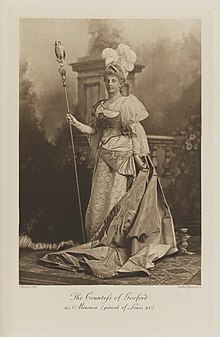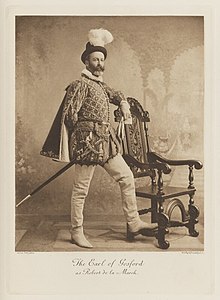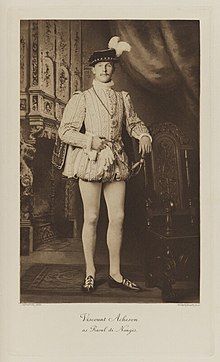Social Victorians/People/Gosford
Also Known As
[edit | edit source]- Family name: Acheson
- Earl of Gosford
- Archibald Brabazon Sparrow Acheson, 4th Earl of Gosford (1864 – 11 April 1922)[1]
- Viscount Acheson
- Archibald Charles Montagu Brabazon Acheson (26 May 1877 – 11 April 1922)[2]
Acquaintances, Friends and Enemies
[edit | edit source]Louisa Acheson, 4th Countess of Gosford
[edit | edit source]- Alexandra, Princess of Wales (Lady of the Bedchamber to Queen Alexandra, 1901–1925[3])
Organizations
[edit | edit source]Archibald Acheson, 4th Earl of Gosford
[edit | edit source]- House of Lords
Timeline
[edit | edit source]1876 August 10, Lady Louisa Montagu and Archibald Acheson married.[4]
1896 June, Louisa Acheson, Countess and Archibald Acheson, Earl of Gosford were present at a tea party at (possibly) Woodlands Park, Iver in Buckinghamshire. Based on a photograph taken at the time and held now in the Royal Trust Collection, also present were Alexandra, Princess of Wales, Lord Howe, Princess Maud of Wales, Princess Victoria of Wales, Hon. Harry Stonor, Colonel Oliphant, Marquis and Marchioness of Ripon, Commander Seymour Fortescue, Lord Colebroke, Lord Curzon, Miss Emilie Yznaga (sister of Consuelo, Duchess of Manchester), Lady Gladwys De Grey, and Jean and Eduoard de Reszke.[5]
1897 July 2, Friday, Louise (née Montagu) Acheson, Countess and Archibald, 4th Earl of Gosford as well as their son Lord Archibald Acheson and their daughter Lady Alexandra Acheson attended the Duchess of Devonshire's fancy-dress ball at Devonshire House. (Louise, Countess Gosford is #140 on the list of people who were present at the ball; Archibald, Earl Gosford is #143; son Lord Archibald Acheson is #255 and Lady Alexandra Acheson is #254.)
1905 June 17, Frederick William Stanley and Lady Alexandra Louise Elizabeth Acheson married.[6]
1910 June 21, Archibald Charles Montagu Brabazon Acheson and Caroline Mildred Carter married.[2]
Costume at the Duchess of Devonshire's 2 July 1897 Fancy-dress Ball
[edit | edit source]Louisa, Lady Gosford
[edit | edit source]
At the Duchess of Devonshire's fancy-dress ball, Louisa Acheson, Lady Gosford was in the Duchess Procession and sat at Table 2 at the first seating for supper.
Lafayette's portrait of "Louisa Augusta Beatrice (née Montagu), Countess of Gosford as Minerva (period of Louis XV)" in costume is photogravure #76 in the album presented to the Duchess of Devonshire and now in the National Portrait Gallery.[7] The printing on the portrait says, "The Countess of Gosford as Minerva (period of Louis XV.)," with a Long S in Countess.[8]
Counterpart of the Greek Athena, Minerva was the Roman patron goddess of wisdom and the intellectual whose sacred animal companion was the owl, which is what is sitting atop Lady Gosford's staff.[9]
Newspaper Accounts of Lady Gosford's Costume
[edit | edit source]The Derbyshire Times and Chesterfield Herald, citing the Daily Mail, printed some gossip suggesting that Louisa, Countess Gosford was not sure about going to the ball as Minerva:
- "Lady Gosford, who was to have been Minerva, has now half decided to be a lady of his [Charles V.'s, in the person of the Duke of Devonshire,] Court."[10]
Archibald Acheson, 4th Earl of Gosford
[edit | edit source]
Archibald Acheson, 4th Earl of Gosford sat at Table 3 for the first supper seating, having escorted the Duchess of York.
Alfred Ellis's portrait of "Archibald Brabazon Sparrow Acheson, 4th Earl of Gosford as Robert de la Marck" in costume is photogravure #77 in the album presented to the Duchess of Devonshire and now in the National Portrait Gallery.[7] The printing on the portrait says, "The Earl of Gosford as Robert de la Marck."[11]
The Historical Robert de La Marck
[edit | edit source]Robert de La Marck is probably Robert III de La Marck (1491– 1537), who was a companion of Francis I at the end of Louis XII's life and called himself Jeune Adventureux.[12] The Encyclopædia Britannica offers a sense of what was generally available to those interested in that kind of research. The discussion of de La Marck that would have been available in 1897, in the 9th edition of the Britannica, is entitled "FLEURANGES, ROBERT (III.) DE LA MARCK, SEIGNEUR DE (1491–1537)":
FLEURANGES, ROBERT (III.) DE LA MARCK, SEIGNEUR DE (1491–1537), marshal of France, historian, was born of an ancient family at Sedan in 1491. A fondness for military exercises displayed itself in his earliest years, and at the age of ten he was sent to the court of Louis XII., and placed in charge of the count of Angoulême, afterwards King Francis I. In his twentieth year he married a niece of the Cardinal d'Amboise, but after three months he quitted his home to join the French army in the Milanese. With a handful of troops he threw himself into Verona, then besieged by the Venetians; but the siege was protracted, and being impatient for more active service, he rejoined the army. He then took part in the relief of Mirandola, besieged by the troops of Pope Julius II., and in other actions of the campaign. In 1512, the French being driven from Italy, Fleuranges was sent into Flanders to levy a body of 10,000 men, in command of which, under his father, he returned to Italy in 1513, seized Alexandria, and vigorously assailed Novara. But the French were defeated, and Fleuranges narrowly escaped with his life, having received more than forty wounds. He was rescued by his father and sent to Vercellae, and thence Lyons. Returning to Italy with Francis I. in 1515, he distinguished himself in various affairs, and especially at Marignano, where he had a horse shot under him, and contributed so powerfully to the victory of the French that the king knighted him with his own hand. He next took Cremona, and was there called home by the news of his father's illness. In 1519 he was sent into Germany on the difficult errand of inducing the electors to give their votes in favour of Francis I.; but in this he failed. The war in Italy being rekindled, Fleuranges accompanied the king thither, fought at Pavia (1525), and was taken prisoner with his royal master. The emperor sent him into confinement in Flanders, where he remained for some years. During this imprisonment he was created marshal of France. He employed his enforced leisure in writing his Histoire des choses mémorables advenues du régime de Louis XII. et de François I., depuis 1499 jusqu' en l'an 1521. In this work he designates himself Jeune Adventureux. Within a small / compass he gives many curious and interesting details of the time, writing only of what he had seen, and in a very simple but vivid style. The book was first published in 1735, by Abbé Lambert, who added historical and critical notes; and it has been reprinted in several coilections. The last occasion on which Fleuranges was engaged in active service was at the defence of Peronne, besieged by the count of Nassau in 1536. In the following year he heard of his father’s death, and set out from Amboise for his estate of La Marck; but he was seized with illness at Longjumeau, and died there in December 1537.[13] (p. 505, Col. 2b – p. 506, Col. 1a)
Newspaper Accounts of Earl Gosford's Costume
[edit | edit source]- The Earl of Gosford was dressed as Robert de la Mark in a "doublet and trunks of purple velvet slashed and puffed with grey satin, the slashes embroidered with gold; short cloak, purple velvet lined with grey satin; large ruff."[14]:p. 42, Col. 2c
- "The Earl of Gosford, as Robert de la Mark, had on doublet and trunks of purple velvet slashed and puffed with grey satin, the slashes being embroidered with gold. Over this he wore a short cloak of purple velvet lined with grey satin."[15]:p. 3, Col. 5a
Lady Acheson (Lady Alexandra Acheson)
[edit | edit source]
Lady Alexandra Louise Elizabeth Acheson, Lady Acheson, was in the Duchess procession. Alfred Ellis's portrait of "Lady Alexandra Louise Elizabeth Stanley (née Acheson) in Hunting Costume, period of Louis XV" in costume is photogravure #78 in the album presented to the Duchess of Devonshire and now in the National Portrait Gallery.[7] The printing on the portrait says, "Lady Alexandra Acheson in Hunting Costume period of Louis XV."[16]
Lord Archibald Acheson
[edit | edit source]
Archibald Charles Montagu Brabazon Acheson was dressed as Raoul di Nangis or as Mignon Henri III.
Alfred Ellis's portrait of "Archibald Charles Montagu Brabazon Acheson, 5th Earl of Gosford when Viscount Acheson as Raoul di Nangis" in costume is photogravure #79 in the album presented to the Duchess of Devonshire and now in the National Portrait Gallery.[7] The printing on the portrait says, "Viscount Acheson as Raoul di Nangis."[17]
At least two possible errors appear in these accounts of Archibald Acheson. According to the Morning Post, like his sister he was in the Duchess procession, which may not be an error because it would be logical for men to have been in the Duchess procession escorting the duchesses, but no other source puts him in that procession. And according to the portrait in the commemorative album held by the NPG, he was Raoul di Nangis rather than Mignon Henri III; Douglas Dawson, whose first name is wrong on his portrait in the commemorative album, is also listed as being Raoul di Nangis, from Les Huguenots. The specificity of the account in the Gentlewoman account lends it credibility, especially about the costume itself, but it is impossible to be certain from this evidence.
Newspaper Descriptions of His Costume
[edit | edit source]- "Lord Acheson, a Mignon (Henri III.), in white satin and crimson velvet, gold and silver."[18]:42, Col. 2c
- Lord Acheson was dressed as "Mignon Henri III.," wearing "pourpoint of white satin beautifully embroidered with bars of special gold embroidery, pearl buttons up the front; trunks, white satin, slashed very full with white silk, the bands embroidered same as doublet; short mantle, crimson velvet, barred and embroidered with gold."[14]:p. 42, Col. 1b
Raoul di Nangis
[edit | edit source]Raoul di Nangis is a character from Giacomo Meyerbeer's 1836 opera Les Huguenots.[19] The opera was in regular performance at Covent Garden in the 1890s; the production with Nellie Melba and Emma Albani in 1895 was well attended and attracted particular notice. Raoul is a tenor's role, the romantic lead. Other people were dressed as characters from this opera as well. William Hay, Marquis of Tweeddale and his daughter Lady Clementine Hay came to the ball as Saint Bris and Valentina. Alexandra, Princess of Wales was dressed as Marguerite de Valois, who was a historical figure and a character in this opera. The Album identifies two men as Raoul de Nangis: Douglas Dawson (whose name is wrong in the Album) and Archibald, Lord Acheson.
Demographics
[edit | edit source]- Nationality: British[1]
Family
[edit | edit source]- Archibald Brabazon Sparrow Acheson, 4th Earl of Gosford (2 August 1841 – 11 April 1922)[20]
- Louisa Augusta Beatrice Montagu Acheson, Countess of Gosford (17 January 1856 – 3 March 1944)[4]
- Archibald Charles Montagu Brabazon Acheson, 5th Earl of Gosford (26 May 1877 – 20 March 1954)
- Lady Alexandra Louise Elizabeth Acheson (1878 – 21 January 1958)
- Lady Mary Acheson (1881–)
- Lady Theodosia Louisa Augusta Acheson (1882–1977)
- Patrick George Edward Cavendish Acheson (30 June 1883 – 30 August 1957)
- Lady Alexandra Louise Elizabeth Acheson (1878 – 21 January 1958)[21]
- Lt.-Col. Hon. Frederick William Stanley (27 May 1878 – 9 August 1942)[6]
- Major David William Stanley (9 August 1906 – 14 January 1997)
- Olivia Mary Beatrice Stanley (1 January 1908 – 9 July 1985)
- Diana Margaret Stanley (18 February 1909 – 2 July 1975)
Relations
[edit | edit source]- Louisa Augusta Beatrice Montagu was the daughter of the Duke of Manchester, so the 3rd child and 2nd daughter of Luisa Cavendish, Duchess of Devonshire.
Notes and Questions
[edit | edit source]Archives and Memoirs
[edit | edit source]- Gosford Papers. Public Record Office of Northern Ireland (PRONI). https://www.rascal.ac.uk/institutions/public-record-office-northern-ireland-proni/gosford-papers. Email: proni@communities-ni.gov.uk. 2 Titanic Boulevard, Titanic Quarter, Belfast, BT3 9HQ, United Kingdom.
Archives
[edit | edit source]- The Rothschild Archive contains "the 'Earl and Countess of Gosford credit account'" (1874-1894, part of a larger collection, which is in 15 volumes).[22]
- Louisa Acheson (née Montagu), Countess of Gosford corresponded with Lord Desborough (c. 1916).[23]
Footnotes
[edit | edit source]- ↑ 1.0 1.1 "Archibald Acheson, 4th Earl of Gosford". Wikipedia. 2020-08-27. https://en.wikipedia.org/w/index.php?title=Archibald_Acheson,_4th_Earl_of_Gosford&oldid=975272339.
- ↑ 2.0 2.1 "Archibald Acheson, 5th Earl of Gosford". Wikipedia. 2020-09-13. https://en.wikipedia.org/w/index.php?title=Archibald_Acheson,_5th_Earl_of_Gosford&oldid=978220303.
- ↑ "Louisa Acheson, Countess of Gosford". Wikipedia. 2022-01-20. https://en.wikipedia.org/w/index.php?title=Louisa_Acheson,_Countess_of_Gosford&oldid=1066882471. https://en.wikipedia.org/wiki/Louisa_Acheson,_Countess_of_Gosford.
- ↑ 4.0 4.1 "Lady Louisa Augusta Beatrice Montagu." "Person Page". www.thepeerage.com. Retrieved 2020-11-05.
- ↑ "Unknown Person - Tea party at Woodlands, June 1896". www.rct.uk. Retrieved 2023-04-07. https://www.rct.uk/collection/2809432.
- ↑ 6.0 6.1 "Lt.-Col. Hon. Frederick William Stanley." "Person Page". www.thepeerage.com. Retrieved 2020-11-05.
- ↑ 7.0 7.1 7.2 7.3 "Devonshire House Fancy Dress Ball (1897): photogravures by Walker & Boutall after various photographers." 1899. National Portrait Gallery https://www.npg.org.uk/collections/search/portrait-list.php?set=515.
- ↑ "Louisa Augusta Beatrice (née Montagu), Countess of Gosford as Minerva (period of Louis XV)." Diamond Jubilee Fancy Dress Ball. National Portrait Gallery https://www.npg.org.uk/collections/search/portrait/mw158432/Louisa-Augusta-Beatrice-ne-Montagu-Countess-of-Gosford-as-Minerva-period-of-Louis-XV.
- ↑ "Minerva". Wikipedia. 2021-10-14. https://en.wikipedia.org/w/index.php?title=Minerva&oldid=1049916346. https://en.wikipedia.org/wiki/Minerva.
- ↑ "Gleanings in the Peak." Derbyshire Times & Chesterfield Herald 1897-07-24 July 1897, Saturday: 6 [of 8], Col. 2b. British Newspaper Archive http://www.britishnewspaperarchive.co.uk/viewer/bl/0000228/18970724/026/0006.
- ↑ "Archibald Brabazon Sparrow Acheson, 4th Earl of Gosford as Robert de la Marck." Diamond Jubilee Fancy Dress Ball. National Portrait Gallery https://www.npg.org.uk/collections/search/portrait/mw158433/Archibald-Brabazon-Sparrow-Acheson-4th-Earl-of-Gosford-as-Robert-de-la-Marck.
- ↑ "Robert III de La Marck". Wikipedia. 2021-03-31. https://en.wikipedia.org/w/index.php?title=Robert_III_de_La_Marck&oldid=1015191788. https://en.wikipedia.org/wiki/Robert_III_de_La_Marck.
- ↑ "FLEURANGES, ROBERT (III.) DE LA MARCK, SEIGNEUR DE (1491–1537)." The Encyclopaedia Britannica: A Dictionary of Arts, Sciences, and General Literature. Ed., Thomas Spencer Baynes. 9th edition. Vol. IX (Vol. 9): Fal–Fyz. 1885. Google Books. Retrieved 16 April 2023. https://archive.org/details/encyclopaedia-britannica-9ed-1875/Vol%209%20%28FAL-FYZ%29%20193323016.23/page/304/mode/2up.
- ↑ 14.0 14.1 “The Duchess of Devonshire’s Ball.” The Gentlewoman 10 July 1897 Saturday: 32–42 [of 76], Cols. 1a–3c [of 3]. British Newspaper Archive https://www.britishnewspaperarchive.co.uk/viewer/bl/0003340/18970710/155/0032.
- ↑ “The Ball at Devonshire House. Magnificent Spectacle. Description of the Dresses.” London Evening Standard 3 July 1897 Saturday: 3 [of 12], Cols. 1a–5b [of 7]. British Newspaper Archive https://www.britishnewspaperarchive.co.uk/viewer/bl/0000183/18970703/015/0004.
- ↑ "Lady Alexandra Louise Elizabeth Stanley (née Acheson) in Hunting Costume, period of Louis XV." Diamond Jubilee Fancy Dress Ball. National Portrait Gallery https://www.npg.org.uk/collections/search/portrait/mw158434/Lady-Alexandra-Louise-Elizabeth-Stanley-ne-Acheson-in-Hunting-Costume-period-of-Louis-XV.
- ↑ "Archibald Charles Montagu Brabazon Acheson, 5th Earl of Gosford when Viscount Acheson as Raoul di Nangis." Diamond Jubilee Fancy Dress Ball. National Portrait Gallery https://www.npg.org.uk/collections/search/portrait/mw158436/Archibald-Charles-Montagu-Brabazon-Acheson-5th-Earl-of-Gosford-when-Viscount-Acheson-as-Raoul-di-Nangis.
- ↑ “Girls’ Gossip.” Truth 8 July 1897, Thursday: 41 [of 70], Col. 1b – 42, Col. 2c. British Newspaper Archive https://www.britishnewspaperarchive.co.uk/viewer/BL/0002961/18970708/089/0041.
- ↑ "Les Huguenots". Wikipedia. 2021-07-02. https://en.wikipedia.org/w/index.php?title=Les_Huguenots&oldid=1031622737. https://en.wikipedia.org/wiki/Les_Huguenots.
- ↑ "Archibald Brabazon Sparrow Acheson, 4th Earl of Gosford." "Person Page". www.thepeerage.com. Retrieved 2021-06-06. https://www.thepeerage.com/p973.htm#i9729.
- ↑ "Lady Alexandra Louise Elizabeth Acheson." "Person Page". www.thepeerage.com. Retrieved 2020-11-05.
- ↑ American and 'Other' Accounts, 1874-1894 (in English). 1874-1894. https://discovery.nationalarchives.gov.uk/details/r/1a819fd8-3602-44c1-9965-6acc926e5344. Rothschild Archive, record in the UK National Archives https://discovery.nationalarchives.gov.uk/details/r/1a819fd8-3602-44c1-9965-6acc926e5344.
- ↑ Letters received by Lord and Lady Desborough, and their children (in English). 1859-1971. https://discovery.nationalarchives.gov.uk/details/r/725fe9fd-caa3-4368-9fe2-5e80399d4c1e. DE/Rv/C1-C2852. https://discovery.nationalarchives.gov.uk/details/r/725fe9fd-caa3-4368-9fe2-5e80399d4c1e.
